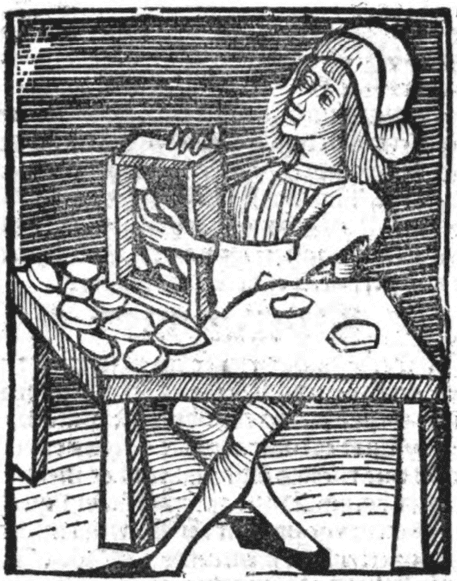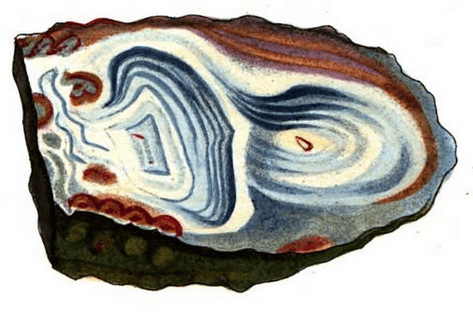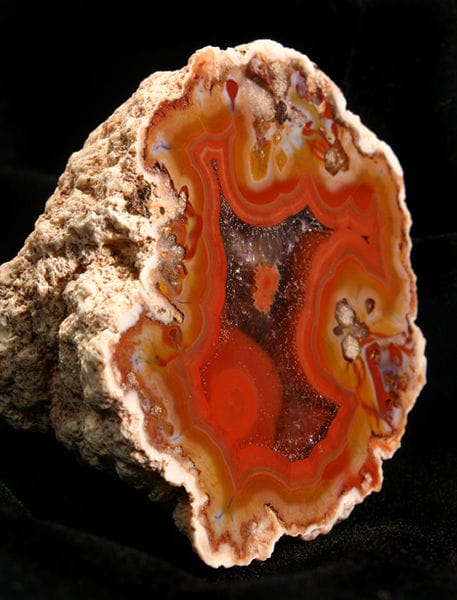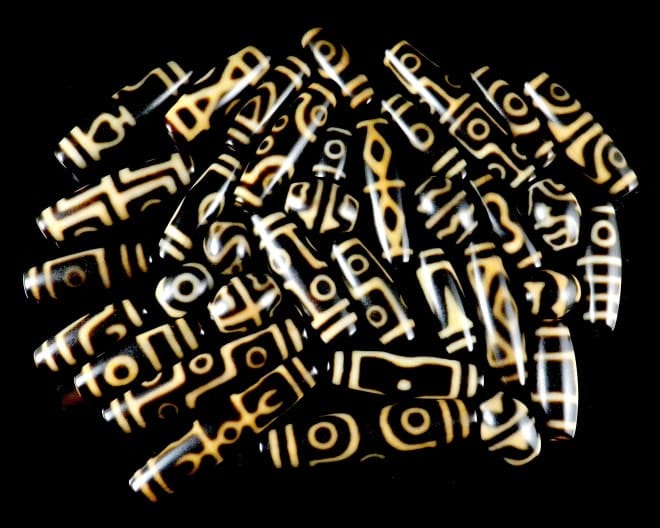Agate
Gagate: Achate: Banded ChalcedonyAkika (Ayurveda)
Aqeeq (Unani)
Ma Nao (‘Horses Brain’, TCM)
Dkar khra man (Tibetan)
Gzi (type of Agate, Tibetan)
 Ortus Sanitatis, Beck, 1517
Ortus Sanitatis, Beck, 1517 Die Mineralien, Weber, J. C., 1871
Die Mineralien, Weber, J. C., 1871 Agate from Argentina
Agate from ArgentinaPhoto by Inucko
 Tibetan Gzi (Dzi) beads, Agate carved into beads and etched.
Tibetan Gzi (Dzi) beads, Agate carved into beads and etched.(Photo by Enijew) (Wikimedia)
Mineralogical name:
Achate; Silicon dioxide with 10-30% admixture; Red Agate contains Iron oxide
Agate consists of chalcedony (crypto-crystalline quartz) with bands of jasper, carnelian, flint, quartz, amethyst, opal etc.
A number of types of Agate were traditionally recognised:
- Achates Albicans, Dendrachates, Mochoa Stone, White-veined Agate with delineations of trees, mosses etc.
- Achates Lacteus, Milky Agate
- Phassachates, Leucachate, Perileucos, Lead-colored Agate
- Achates impurior, flesh-colored (impure white) Agate
- Achates Sanguineus, Haemachates, Blood Agates, Blood-colored Agate
- Achates Carneus, Sardachate, Carnelian Agate; cloudy and spotted flesh-colored Agate.
- Achates Miniaceus, Coralo-achates, Coral Agate, red lead colored Agate
- Achates flavescens, Cerachates, Wax-colored Agate
- Achates Leonteseres, Leonina, Pale yellow Agate, Lion Agate
- Achates fuscus venis, black-veined Brown Agate
- Achates fuscovirens, Jaspachate, Jasp-Agate, greenish-brown variegated Agate
In Tibet, a type of Agate called Gzi (sometimes written Dzi) is highly praised. These are carved, etched stones with particular patterns. These stones are sometimes used in medicinal formulas, especially some of the Precious Pills. Their uses are generally similar to Agate.
Parts used:
Several kinds were known and used. In general, Blood-red Agate was preferred in all systems. Salmon listed Coral-like, Indian, and that from Crete. Ayurveda regards Red Agate as best; Unani also uses a Green Agate
NOTE: Gagates of Dioscorides and Pliny was Jet, a black mineral between Amber and Coal which burns with a thick smoke and strong smell. This was often confused for Agate as both were said to have derived their name from the River Achates in Sicily.
Temperature & Taste:
Cool, dry. Sweet, slightly Pungent
Properties:
Streak: White
Cleavage: None
Fracture: Conchoidal
Lustre: Waxy
Tenacity: Brittle
Transparency: sub-translucent
Hardness: 6–7
Specific Gravity: 2.5–2.6
Fluorescence: none
Uses:
1. Clears Heat, Strengthens the Heart, Calms the Mind and Spirit:
-Agate is used in Ayurveda to promote Calmness and ease Anxiety
-Mental Illness, Lunacy (Ayurveda)
-Evil Spirits and Demons, for which it is still used in Tibetan Medicine
-Depression and Lethargy
-Insomnia (Albertus, Salmon).
-Epilepsy (Tibetan Medicine)
-strengthen the Head, and is used as a Brain tonic. (Unani)
-‘makes a man mighty, pleasant, helps against adversities’
–Bhasma is used as a cardiotonic in Heart disease and weakness of the Heart; also for Palpitations. (Ayurveda)
-promotes Complexion.
2. Clears Heat, Resists Poison:
-Fever, Plague, Pestilence, Epidemic Disease (Ayurveda, West, Tibetan)
-venomous bites of the Snake, Spider, Scorpion etc.; taken internally and applied (Salmon, Culpeper)
-‘Agates are a safeguard against the bite of the Spider, and Eagles carry them to their nests to defend their fledglings against venomous animals’. (Lexicon of Alchemy, Rulundus)
-Liver Fire with associated Liver Yin deficiency (TCM, Hong-Yen Hsu, Oriental Materia Medica)
-quench the Thirst in Fevers. (Camel drivers held Agate pieces in their mouth to avoid thirst)
3. Clears Heat, Clears the Eyes:
-red, Inflamed eyes
-‘strengthens Sight’ (Lexicon of Alchemy, Rulundus)
-clear heat from the Eyes; also Cataracts (TCM)
-Agate is likewise used for the eyes when prepared, both internally and externally as a collyrium, in Ayurveda.
4. Clears Heat, Stops Bleeding:
-checks menstruation (Psellus)
-Ulcers and Hemorrhage. (Unani)
-bleeding, bloody Leukorrhea and blood in the sputum; regarded as especially effective in excess Menstrual bleeding. (Ayurveda)
-bleeding of the gums, and makes them strong when applied topically.
5. Benefits Kidneys, Strengthens the Essence:
-Regarded as Aphrodisiac is Unani and Ayurveda
-when excess Heat damages the Yin
-said to restore vigor and strength.
-used in Elixirs of Immortality by Taoists.
6. Stops Cough:
-The Bhasma is used for Bronchitis and Asthma. (Ayurveda)
7. Clears Damp, Promotes Urine:
-Checks water accumulations in dropsy (Psellus)
–Bhasma is used for Edema, Stones and Gravel (Unani, Ayurveda).
Gzi (Agate type) of Tibet
-primarily for Headaches, Epilepsy etc.
-Eye Diseases
-Protects from Evil: widely worn around the neck by Tibetan to protect from evil.
Dose:
Levigated Powder (Pishti): 125–250mg;
Bhasma: 125–250mg, up to 500mg
Signature:
The clear bands of Agate have a signature of separation and clarification. Helping to separate clear from turbid, both within the Fluids of the body, and in the Mind and Spirit.
Main Combinations:
1. Palpitation, Heart weakness, take levigated Agate with Apple syrup. (Unani)
2. Epilepsy, Agate, Red Coral, Pearl
3. Aphrodisiac, Agate Bhasma is combined with Gold in Ayurveda.
Major Formulas:
Safoof e Jawahar Mohra (Precious Defender Powder)
Precious Wish Fulfilling Jewel (Rin chen ratna bsam ‘phel) (Tibetan)
Cautions:
Standard cautions for using Gem stones.
Main Preparations used:
Levigated stone; Bhasma
